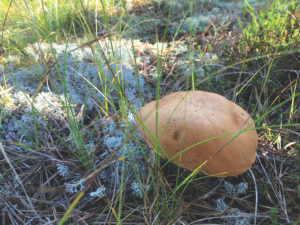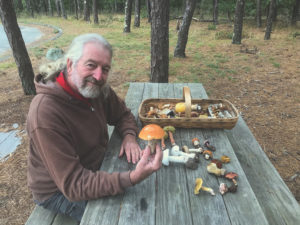
The Outer Cape’s sandy, acidic soils are generally seen as inhospitable for food crops. But every fall, people travel from across New England and farther afield to visit our dunes and pine forests, looking for the special mushrooms that thrive in nutrient-poor soils and in symbiotic relationships with pines and oaks.
The number of mushroom foragers has increased in recent years, said Bill Yule of Haddam, Conn., who was picking mushrooms at Wellfleet’s Great Island in the Cape Cod National Seashore last week. Yule drove here expressly to forage, as he has done for many years.
No one the Independent interviewed for this story would admit to selling foraged mushrooms from the Outer Cape to fancy restaurants in the city. One Russian collector at Great Island told a reporter that there were “no mushrooms today” as she filled the trunk of her car with fungi.

Yule said that not all foragers are respectful environmental stewards. “Some people come out and grab everything they see,” he said. “Some people rake the pine duff, looking for matsutake buttons to sell in Boston. It’s not huge, but it gets bigger every year.”
Matsutake and porcini, also known as boletes, are both tasty mushrooms that grow in piney woods across the Cape. They can command high prices, $40 to $50 per pound and sometimes higher.
Liam Luttrell Rowland, the chef at Spindler’s in Provincetown, said this week that, on rare occasions, he buys local matsutake harvested by trusted foragers.
“I don’t like the idea of someone coming to the Cape and making a bunch of money harvesting mushrooms,” Luttrell Rowland added. Safety and legality are his top priorities, he said.
Mushroom fever breaks the rules
Within the boundaries of the National Seashore an individual is allowed to pick up to five gallons of mushrooms per day for home use. Digging in or disturbing the soil while collecting, however, is strictly prohibited. Furthermore, collecting mushrooms for sale is “completely illegal,” said Seashore Supt. Brian Carlstrom. “It’s for personal consumption only.”
Carlstrom said that citations have been issued for overcollection in the past. Although the Seashore is not actively monitoring mushroom foragers, “Our rangers are looking for anything that might seem excessive,” he said.
Mass Audubon’s Wellfleet Bay Sanctuary has also experienced some illicit collecting.
Director Melissa Lowe Cestaro said that people often forage in the sanctuary despite its strict
no-collection policy. “We require people to stay on trails,” she said, “and foraging takes you off-trail and sometimes into sensitive conservation areas.”
Cestaro said that illicit foraging has been a problem each fall in her 25 years at Audubon. Mushroom hunters often sneak into the sanctuary from West Road, parking their cars a few feet away from the signs prohibiting collection.
From the large quantity of their hauls, Cestaro infers that foragers might be selling their mushrooms. “Sometimes I see people with a carload of mushrooms,” she said. “It’s not like you can eat a truckload in a day.”
It’s a sport for the Russians
Lucy Lins of North Falmouth was the disappointed forager at Great Island last week whose car trunk contained several boxes of boletes, of which porcini are a subgroup.
Lins is Russian, and she said that mushroom foraging is the Russian equivalent of recreational fishing. “It’s a sport — something you do just for fun,” she said. “You spend time outside and walk around.” Lins claimed that she would enjoy foraging even if no tasty mushrooms could be found.
Ilya Bernstein of New York grew up in the former U.S.S.R. and has spent several autumns in Truro. He explained that collecting mushrooms is a popular weekend activity in Russia.
“Russian peasants, traditionally, have had very little food of their own,” Bernstein said. “For long stretches of history, they ate mushrooms.” In the 1960s it became fashionable among city dwellers to spend a day foraging in the countryside, he said.
Russian foragers look specifically for boletes, Bernstein said. He doubted that anyone was selling them, though. “They’re very beautiful,” he said. “But [boletes] look better than they taste.”
Foraging on the Cape has a reputation among the Russian foragers.
“There’s a story that Russians tell — a mushroom horror story,” Bernstein said. “One day, someone went and gathered several bags of mushrooms. They were stopped by a ranger in the parking lot and forced to dump them all out” — a complete waste of perfectly good fungi. “From the perspective of a mushroom picker, it’s a complete outrage,” said Bernstein.
Guarding mushroom knowledge and ecosystems
Overcollecting and trampling of forest vegetation could have long-term effects on Cape Cod’s ecosystems, and mycologists worry that if word gets out about the valuable species growing here, the situation will only get worse.
Wesley Price, head of the Cape Cod Mycological Society, said that foraging has increased in recent years. “The awareness of what we have is growing,” Price said. “Caring for that resource is not always foremost in people’s mind when they’re foraging.”
Although there’s little research on how much harvesting is too much, overcollecting could result in fewer fungi. If mushrooms are collected before they have a chance to drop their spores and reproduce, “it could impact the overall health of the species and genetic diversity,” Price said.
Bill Neill, a mycologist and co-author of Cape Cod Mushrooms, said that the increasing number of foragers in the woods is changing the landscape. “It’s not like people go from point A to point B,” said Neill. “It’s all cow trails, meandering though the pines. Certain places just get so trampled. It must be taking its toll.”
Fungi play important roles in the ecosystems of Cape Cod. Many fungi live below ground, where we can’t see them, and their mycelia — tiny, spindly roots — are microscopic. In one square foot of soil, there are miles of mycelial threads, which connect to surrounding trees to exchange nutrients and water.
Without these symbiotic relationships between fungi and trees, “There would be a lot less forest than there is now,” Neill said. “Out in the wind, it’s a very hostile environment, and fungi are a big reason why the forests can survive.”
